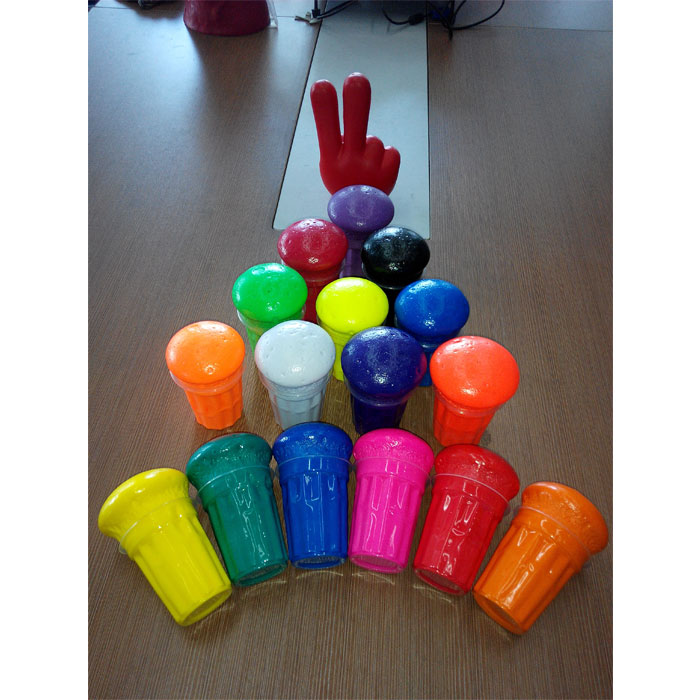poliuretano elastomer formed by the polymerization reaction of diisocyanate and active hydrogen compound, the rigid segment containing urea group composed of diisocyanate and diamine chain extender, the glass transition temperature is much higher than room temperature, and it is glassy at room temperature. Subcrystals or microcrystals form the plastic phase; flexible segments of polyether or polyester are gathered together to form the matrix or matrix of the poliuretano rubber. Because its glass transition temperature is lower than room temperature, it is called the rubber phase. The microphase separation of the poliuretano elastomer makes the poliuretano elastomer have the advantages of good wear resistance, wide range of hardness, high strength and high elongation, large load supporting capacity, good shock absorption effect and excellent oil resistance. Choosing a suitable molding and processing method can maximize the performance of poliuretano elastomers and prepare various poliuretano elastomers with excellent properties, which are widely used as plastics, rubber, fibers, adhesives and coatings, and even as functional polymer materials. Such as medical poliuretanomateriali.
1.1 Principi generali per la selezione dei metodi di lavorazione della formatura
(1) Il processo di stampaggio consiste solitamente nel fondere o deformare un composto polimerico allo stato solido (polvere o granulare), in pasta o in soluzione, e formare la forma desiderata attraverso uno stampo, mantenere la forma che è stata ottenuta e infine ottenere il prodotto. processo di lavorazione.
(2) Flusso di processo di stampaggio comune: â‘ Il metodo per formare la miscela di composti polimerici una e due volte per produrre prodotti; â‘¡Il metodo per formare il composto polimerico per produrre prodotti contemporaneamente; â‘¢Il metodo per produrre prodotti dalla miscela di monomeri in un unico passaggio â‘£ Metodo di produzione in un unico passaggio della miscela di oligomeri.
(3) Prestazioni di lavorazione e suoi fattori di influenza: â‘ Spremibilità, nell'estrusore, nella canna della macchina ad iniezione, nei rulli della calandra e nello stampo, quando il materiale viene deformato per estrusione, si ottiene la forma del materiale e capacità mantenuta. I suoi fattori restrittivi: viscosità del fuso, struttura dell'attrezzatura di lavorazione, reologia del fuso e portata del fuso. â‘¡Modificabilità, nel processo di stampaggio sotto l'azione della macchina a iniezione, dell'estrusore e della macchina a compressione, il materiale si deforma sotto l'azione della temperatura e della pressione e la capacità di essere modellato nello stampo. I suoi fattori restrittivi: reologia, proprietà termiche e altre proprietà fisiche e meccaniche e reattività chimica dei composti polimerici. â‘¢Estensibilità, nella calandratura o stiramento, il materiale viene deformato mediante calandratura o stiramento in una o due direzioni. I suoi fattori restrittivi: la plasticità del materiale e l'effetto di incrudimento. â‘£ Spinnability, l'ugello durante lo stampaggio per estrusione, la capacità del materiale di formare fibre solide continue attraverso lo stampaggio. I suoi fattori restrittivi: reologia, viscosità e resistenza del fuso, stabilità termica e stabilità chimica.
1.2 Principi generali per la selezione dei metodi di stampaggio e lavorazione perpoliuretanoelastomeri
poliuretano elastomer molding processing system is divided into liquid system and solid system. On the basis of the rapid polymerization reaction of diisocyanate and active hydrogen compound, the molding processing method is conducive to the microphase separation of the poliuretano elastomer. , Liquid system, poliuretano casting glue can be processed by casting (manual casting, centrifugal casting and vacuum casting), reaction injection molding, spraying, knife coating, roller coating, laminating, laminating, bonding, vulcanizing, pasting and rubbing ; Solid system, poliuretano compound rubber can be vulcanized and laminated with mold, poliuretano thermoplastic can be used with thermoplastic, hot injection, calendering, blow molding, spinning and lamination.
1.3 Il principio di corrispondenza dei tipi di base e dei metodi di lavorazione dello stampaggio
poliuretanol'elastomero è un polimero alto tra plastica e gomma in termini di modulo. Comprende principalmentepoliuretano compound rubber, poliuretano cast rubber, poliuretano water emulsion and poliuretano thermoplastic. poliuretano leather, poliuretano adhesives, poliuretano coatings, poliuretano compounds, poliuretano casting glues, poliuretano fibers, poliuretano water emulsions and poliuretano thermoplastics are all derived from the above four types of glue. The molding and processing methods of poliuretano compound rubber, poliuretano water emulsion and poliuretano thermoplastic generally belong to the molding processing methods of rubber, coatings and plastics.
1.4 The use of poliuretano elastomers and the matching principle of production continuity and molding processing methods
poliuretano elastomer molding and processing methods are matched with the use of poliuretano elastomers, taking into account the continuity of production. For example, poliuretano leather molding methods usually use poliuretano casting adhesive or foaming layer, poliuretano water emulsion and poliuretano thermoplastic as the surface layer; also available poliuretano thermoplastic and poliuretano water emulsion are used as leather separately, which are based on the basic rubber molding processing method, supplemented by foam molding processing, usually calender molding processing method is selected. poliuretano paving materials are made of poliuretano casting glue, mainly due to the large product shape and low precision requirements. Medical poliuretano materials have good chemical stability, tissue compatibility, and resistance to biological aging, so the molding process uses dip coating, pouring and coating methods.


